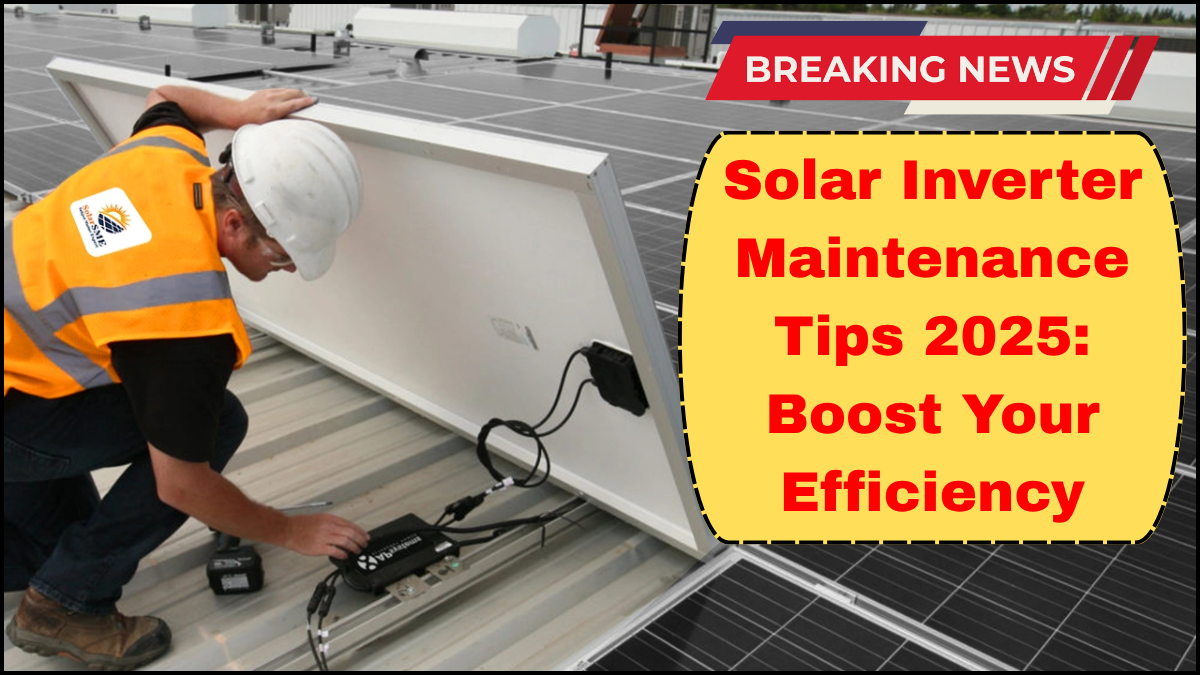A solar inverter is the heart of any solar power system. It converts the direct current (DC) electricity generated by solar panels into usable alternating current (AC) electricity for homes and businesses. As technology advances and more people invest in renewable energy, ensuring optimal performance of your inverter becomes increasingly vital. These Solar Inverter Maintenance Tips for 2025 will help you boost efficiency, prolong the lifespan of your system, and protect your investment.

Understand Your Inverter Type
Before diving into maintenance, identify which type of inverter you’re using:
-
String Inverters – Common in residential systems, usually mounted on walls.
-
Microinverters – Installed on individual panels.
-
Hybrid Inverters – Support battery backup systems.
-
Grid-tied Inverters – Integrated with the utility grid for energy export.
Each type has unique upkeep requirements, so check the manufacturer’s manual and understand your model’s design and capabilities.
Keep It Clean and Clear
Dirt and dust accumulation can obstruct airflow and cause overheating, especially in outdoor installations. Make it a habit to:
-
Wipe down the exterior of the inverter with a dry or slightly damp cloth every 1-2 months.
-
Clear out surrounding debris, like leaves or spider webs, that may block ventilation grills.
-
Avoid using chemical cleaners that can corrode surfaces or leave residue.
If your system is in a dusty or humid region, increase inspection frequency to monthly.
Monitor System Performance Regularly
Modern inverters offer monitoring platforms or apps that show real-time system data. Here’s what to look for:
-
Daily output levels – Consistent drops could indicate a malfunction.
-
Error codes or warning lights – Address these immediately, even if the system still seems operational.
-
Comparative performance – Track energy production year-over-year to spot performance degradation.
Use the analytics from your solar monitoring app to detect irregularities before they turn into costly problems.
Check Connections and Wiring
Loose or corroded electrical connections can lead to power loss or system failure. Schedule a visual inspection every 6-12 months:
-
Ensure wires are tight and secure at terminals.
-
Look for signs of corrosion, discoloration, or fraying.
-
Watch for rodent activity around wiring, especially in ground-mounted setups.
If you’re not comfortable doing this yourself, hire a licensed technician for a full inverter diagnostic.
Ensure Proper Ventilation
Inverters produce heat while converting energy, and without adequate ventilation, they can overheat and shut down. Best practices include:
-
Installing the inverter in a shaded and well-ventilated area.
-
Ensuring a minimum clearance (as specified in the manual) around the inverter for airflow.
-
Avoiding direct sunlight exposure—install an awning or place it in a utility room if possible.
Overheating reduces efficiency and wears down internal components faster.
Update Firmware and Software
With solar technology evolving, manufacturers often release firmware updates that improve inverter efficiency and introduce new features. Make sure to:
-
Check for updates every quarter, especially if your inverter connects to a monitoring app.
-
Follow manufacturer instructions or contact support for safe updating.
-
Use official firmware only to avoid compatibility issues.
Keeping your inverter software up to date is an easy win for better performance.
Schedule Professional Servicing
Even with regular DIY checks, a professional technician should inspect your system every 1-2 years. They can:
-
Run thermal scans to detect overheating.
-
Perform load tests to confirm efficiency.
-
Identify hidden faults that may not trigger error codes.
For those with grid-tied inverter systems, professional servicing is crucial to comply with local utility regulations and avoid disconnects during inspections.
Protect Against Power Surges
Surge protection is critical, especially in areas prone to lightning or unstable grid supply. Here’s how:
-
Install surge protection devices (SPDs) between the inverter and main electrical panel.
-
Use voltage regulators to stabilize inconsistent grid input.
-
Consider a dedicated breaker for your inverter for manual shutoff during grid faults.
Investing in these safeguards can prevent irreversible inverter damage and unnecessary downtime.
Document Maintenance Activities
Maintain a simple logbook or digital record of all maintenance tasks, including:
-
Cleaning dates
-
Inspection notes
-
Error messages and resolutions
-
Service technician visits
This documentation helps track your system’s health and speeds up diagnosis during troubleshooting.
FAQs on Solar Inverter Maintenance
Q1: How often should I clean my solar inverter?
A: Clean the exterior every 1-2 months, or more frequently if installed outdoors in a dusty or humid area.
Q2: Can I perform inverter maintenance myself?
A: Basic cleaning and monitoring can be DIY, but electrical inspections and servicing should be handled by certified professionals.
Q3: What are signs my inverter needs repair?
A: Common signs include unexpected drops in energy output, persistent error codes, unusual noises, and hot surface temperatures.
Q4: Do grid-tied inverters need special maintenance?
A: Yes, grid-tied inverter upkeep includes ensuring compliance with utility standards, surge protection, and proper synchronization with the grid.
Q5: Is inverter maintenance covered by warranty?
A: Most warranties cover defects, not regular maintenance. Always check your warranty terms before scheduling service.
click here to learn more



